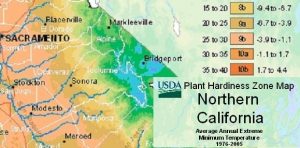Elevation-Specific Gardening
When Master Gardener writers met recently to schedule the next series of media articles, it was decided that January would be devoted to the topic of garden planning. As we discussed various topics, we were surprised to discover how different from each other our gardening experiences are.
As an example, when talking about “wildlife in the garden” I mentioned that white-crowned sparrows and juncos had returned to my yard (at approximately 1500’ in elevation) for the winter. Another master gardener replied, “They’re in my yard (approximately 3500’) all year round. A third, who lives in Oakdale, never sees these particular birds.
Moving on to discuss the topic of planting dates, we discovered that the Oakdale master gardener plants early in the spring. I, however, who spent 25 years living at an elevation of almost 4000’, still can’t get used to planting before Mother’s Day – which means sometimes my veggies go into the ground late and end up battling excessive heat in Jamestown. The higher-elevation master gardener never plants before Mother’s Day. And, then, sometimes her garden faces late snow and killing frosts.
Certain plants, such as sugar and Jeffrey pines, thrive at higher elevations and would perish at lower elevations. Other plants, such as citrus, can grow easily in Oakdale, while they would freeze to death in Mi-Wuk.
So, the first principle in planning your garden is: KNOW YOUR ELEVATION. Elevation impacts so much more than just the average high and low temperature at your location. It can have an impact on soil types, rainfall, wind, humidity, heat and light.
Soils at higher elevations tend to be thinner, lower in nutrient content, rockier and more granitic. Lower-elevation soils tend to be much higher in clay content and, thus, richer in nutrients and water holding ability.
Elevation can also affect air movement and light. We’re all familiar with increased wind gusts over mountain passes. Alpine plants living above tree line are often low growing or twisted in response to tougher conditions and prevailing winds at high elevations. And the tall evergreens of mixed conifer forests at higher elevations provide much more shade, lowering the ambient temperature and increasing humidity,
The USDA Plant Hardiness Zone Map released in 2012, updated the more general information found on the 1990 map. As an example, when queried, the interactive 1990 map placed Jamestown, Twain Harte and Mi-Wuk Village all in the same zone. The 2012 map sorts locations into different zones, taking into account elevation, closeness to large bodies of water, and whether the location is in a valley or on a ridge top.
Be aware that hardiness zones or planting zones have large boundaries and may not be exact enough for your site. Zones grade into and out of each other gradually and irregularly. Rely on your own experience in your garden and determine the effects of your elevation upon your specific situation.
If you are looking for assistance in finding plants that will thrive in your location, check out High Country Gardens. Their interactive site will give you a selection of plants based upon zip code. Also, Las Pilitas Nursery, will provide a list of California native plants based upon your zip code or city name.
Rebecca Miller-Cripps is a University of California Cooperative Extension Master Gardener of Tuolumne County who has lived in both high and low-elevation locations in the county.
UCCE Master Gardeners of Tuolumne and Calaveras Counties can answer home gardening questions. Call 209-533-5912 or go to: http://ucanr.edu/survey/survey.cfm?surveynumber=7269 to fill out our easy-to-use problem questionnaire. Check out our website at: http://cecentralsierra.ucanr.edu/Master_Gardeners/ You can also find us on Facebook.

